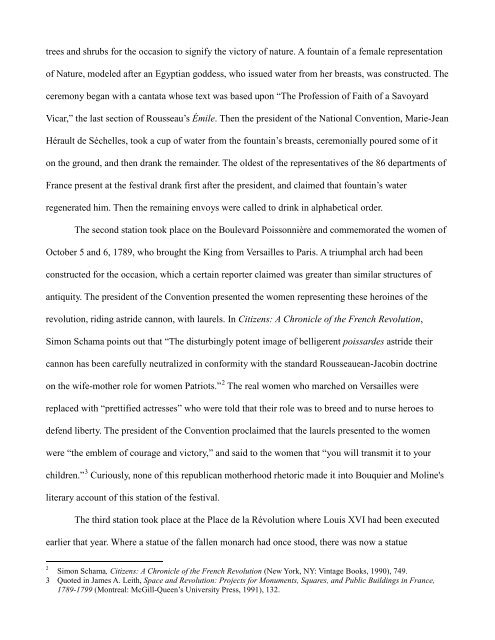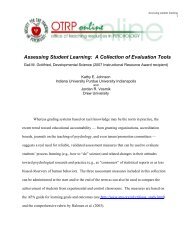Jacques-Louis David and the Festival of Unity ... - Xavier University
Jacques-Louis David and the Festival of Unity ... - Xavier University
Jacques-Louis David and the Festival of Unity ... - Xavier University
You also want an ePaper? Increase the reach of your titles
YUMPU automatically turns print PDFs into web optimized ePapers that Google loves.
trees <strong>and</strong> shrubs for <strong>the</strong> occasion to signify <strong>the</strong> victory <strong>of</strong> nature. A fountain <strong>of</strong> a female representation<br />
<strong>of</strong> Nature, modeled after an Egyptian goddess, who issued water from her breasts, was constructed. The<br />
ceremony began with a cantata whose text was based upon “The Pr<strong>of</strong>ession <strong>of</strong> Faith <strong>of</strong> a Savoyard<br />
Vicar,” <strong>the</strong> last section <strong>of</strong> Rousseau’s Émile. Then <strong>the</strong> president <strong>of</strong> <strong>the</strong> National Convention, Marie-Jean<br />
Hérault de Séchelles, took a cup <strong>of</strong> water from <strong>the</strong> fountain’s breasts, ceremonially poured some <strong>of</strong> it<br />
on <strong>the</strong> ground, <strong>and</strong> <strong>the</strong>n drank <strong>the</strong> remainder. The oldest <strong>of</strong> <strong>the</strong> representatives <strong>of</strong> <strong>the</strong> 86 departments <strong>of</strong><br />
France present at <strong>the</strong> festival drank first after <strong>the</strong> president, <strong>and</strong> claimed that fountain’s water<br />
regenerated him. Then <strong>the</strong> remaining envoys were called to drink in alphabetical order.<br />
The second station took place on <strong>the</strong> Boulevard Poissonnière <strong>and</strong> commemorated <strong>the</strong> women <strong>of</strong><br />
October 5 <strong>and</strong> 6, 1789, who brought <strong>the</strong> King from Versailles to Paris. A triumphal arch had been<br />
constructed for <strong>the</strong> occasion, which a certain reporter claimed was greater than similar structures <strong>of</strong><br />
antiquity. The president <strong>of</strong> <strong>the</strong> Convention presented <strong>the</strong> women representing <strong>the</strong>se heroines <strong>of</strong> <strong>the</strong><br />
revolution, riding astride cannon, with laurels. In Citizens: A Chronicle <strong>of</strong> <strong>the</strong> French Revolution,<br />
Simon Schama points out that “The disturbingly potent image <strong>of</strong> belligerent poissardes astride <strong>the</strong>ir<br />
cannon has been carefully neutralized in conformity with <strong>the</strong> st<strong>and</strong>ard Rousseauean-Jacobin doctrine<br />
on <strong>the</strong> wife-mo<strong>the</strong>r role for women Patriots.” 2 The real women who marched on Versailles were<br />
replaced with “prettified actresses” who were told that <strong>the</strong>ir role was to breed <strong>and</strong> to nurse heroes to<br />
defend liberty. The president <strong>of</strong> <strong>the</strong> Convention proclaimed that <strong>the</strong> laurels presented to <strong>the</strong> women<br />
were “<strong>the</strong> emblem <strong>of</strong> courage <strong>and</strong> victory,” <strong>and</strong> said to <strong>the</strong> women that “you will transmit it to your<br />
children.” 3 Curiously, none <strong>of</strong> this republican mo<strong>the</strong>rhood rhetoric made it into Bouquier <strong>and</strong> Moline's<br />
literary account <strong>of</strong> this station <strong>of</strong> <strong>the</strong> festival.<br />
The third station took place at <strong>the</strong> Place de la Révolution where <strong>Louis</strong> XVI had been executed<br />
earlier that year. Where a statue <strong>of</strong> <strong>the</strong> fallen monarch had once stood, <strong>the</strong>re was now a statue<br />
2 Simon Schama, Citizens: A Chronicle <strong>of</strong> <strong>the</strong> French Revolution (New York, NY: Vintage Books, 1990), 749.<br />
3 Quoted in James A. Leith, Space <strong>and</strong> Revolution: Projects for Monuments, Squares, <strong>and</strong> Public Buildings in France,<br />
1789-1799 (Montreal: McGill-Queen’s <strong>University</strong> Press, 1991), 132.

















